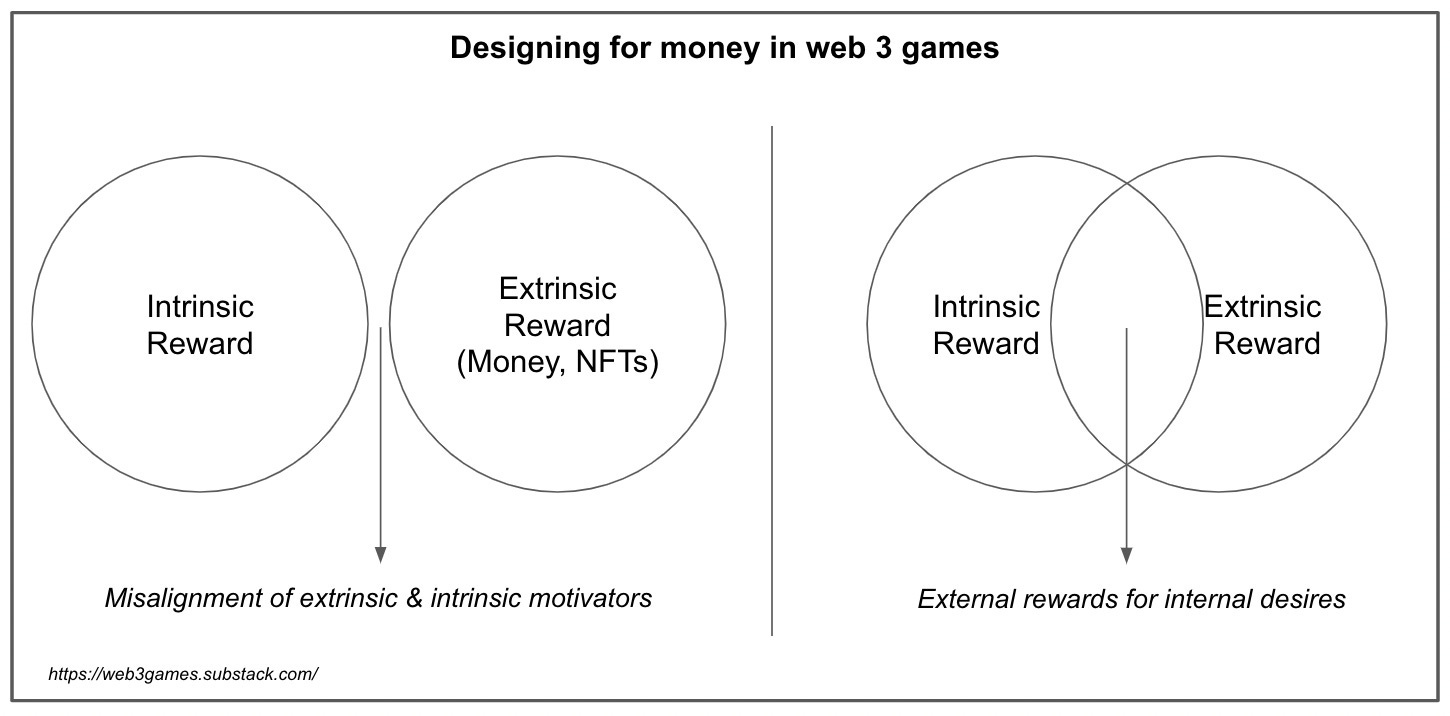How Money Fundamentally Impacts Player Motivations in Web3 Games
Introduction
Blockchain allows web 3 games to add ownership and tradability to their games. This means that it allows monetary value to be assigned to in-game items and rewards.
However, adding money to a game without understanding how it impacts player behaviours is also dangerous.
The objective of this article is to share some thoughts on how money changes player behaviours and how web 3 games can adapt their incentive and game designs.
Impact of Money on Player Motivations
There are many different theories on player motivations and what makes a game ‘fun’.
But when analysing ownership & real money, it’s interesting to look at it from the perspective of intrinsic vs extrinsic motivation.
-
Intrinsic motivation: an innate drive to pursue or do something which is reward in and of itself
-
Extrinsic motivation: an external reward or punishment pushes someone to do (or avoid) something
Money is an example of an extrinsic motivator and completely changes the player dynamics in many ways. Let’s look at some examples:
-
Players assign monetary value to their time: Assigning monetary value to in-game actions detracts from the satisfaction and intrinsic desire of players. This is proven in psychological studies and also applies to games. For example, imagine playing 20 hours and then receiving a legendary sword, but then finding out that anyone could have bought the sword for $1. Some players will assign a value to their time of $1 for 20 hours, which may detract from their original enjoyment of the game.
-
Experiencing the dichotomy of fun and money: There is a natural tension between fun and money. For many people, games are associated with relaxation and enjoyment. They are played to wind down and escape from the real world. On the other hands, money is both stressful and very real. As such, there is a fundamental dichotomy between fun and money, and web 3 games are at the highest risk of being impacted by this dichotomy.
-
Alignment between intrinsic and extrinsic rewards: Games with in-game economies (i.e. MMOs, RPGs) have always had a conflict between incentivising players to pursue intrinsic and extrinsic rewards. This is because in order to progress in these games, there is usually some way to ‘min-max’ or ‘optimise’ your play. However, the most “optimal” way to progress isn’t also always the most fun. For example, imagine if killing chickens was extremely optimal (i.e. high extrinsic reward), but also extremely boring (low intrinsic reward). Players would kill a million chickens and enjoy the extrinsic reward afterwards, but it would be a terrible experience. Money in web 3 games takes this a step further as the extrinsic reward of money can completely overwhelm the intrinsic desires of accomplishment, completion, etc.
-
Unique actors in gaming as value extractors: Having real money in a game leads to a new category of players (or organisations) which are purely value extractors. In their efforts to value extract from the economy, these groups also impact other player experiences. As an example, mass botting can affect other players who encounter them in matchmaking. Or for example, groups who monopolise one part of the market might end up creating a massive barrier of entry for new players.
Some solutions
Understanding the challenges above will allow games to consider challenges. Some examples of what can be done to ensure money impacts player motivations in a positive way include:
-
Increasing the distance between monetary value and reward - For example abstracting via other currencies or de-emphasising financial value as the objective
-
Leverage NFTs and tokens to provide social & emotional value - Ownership doesn’t just enable trading. The properties of NFTs (scarcity, provenance) and way in which they are designed into the game experience should go beyond just monetary value.
-
Overlap the extrinsic with intrinsic motivations - Making it so that the things that are ‘fun’ to do in the game are also the most efficient for earning reward
-
Understand how non-player groups will take money incentives to the extreme - Games need to be able to predict how non-traditional player segments (earners, investors) will interact with the money elements of the game. They need to ensure these interactions are not at the detriment of the player experience.
Illustration: Overlapping extrinsic & intrinsic motivations:

Web 3 games is super new and despite the tone of this article I am super excited about its potential (see write up here).
With that said, money does fundamentally affect player motivations which is why web 3 game designs need to be built from the ground up in order to deliver the best experience.





Reviews